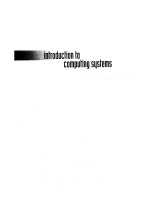Lecture Introduction to computing systems (2/e): Chapter 8 - Yale N. Patt, Sanjay J. Patel
Bạn đang xem bản rút gọn của tài liệu. Xem và tải ngay bản đầy đủ của tài liệu tại đây (343.57 KB, 19 trang )
Chapter 8
I/O
Copyright © The McGraw-Hill Companies, Inc. Permission required for reproduction or display.
I/O: Connecting to Outside World
So far, we’ve learned how to:
• compute with values in registers
• load data from memory to registers
• store data from registers to memory
But where does data in memory come from?
And how does data get out of the system so that
humans can use it?
82
Copyright © The McGraw-Hill Companies, Inc. Permission required for reproduction or display.
I/O: Connecting to the Outside World
Types of I/O devices characterized by:
• behavior: input, output, storage
input: keyboard, motion detector, network interface
output: monitor, printer, network interface
storage: disk, CD-ROM
• data rate: how fast can data be transferred?
keyboard: 100 bytes/sec
disk: 30 MB/s
network: 1 Mb/s - 1 Gb/s
83
Copyright © The McGraw-Hill Companies, Inc. Permission required for reproduction or display.
I/O Controller
Control/Status Registers
• CPU tells device what to do -- write to control register
• CPU checks whether task is done -- read status register
Data Registers
• CPU transfers data to/from device
Control/Status
CPU
Output Data
Graphics Controller
display
Electronics
Device electronics
• performs actual operation
pixels to screen, bits to/from disk, characters from keyboard
84
Copyright © The McGraw-Hill Companies, Inc. Permission required for reproduction or display.
Programming Interface
How are device registers identified?
• Memory-mapped vs. special instructions
How is timing of transfer managed?
• Asynchronous vs. synchronous
Who controls transfer?
• CPU (polling) vs. device (interrupts)
85
Copyright © The McGraw-Hill Companies, Inc. Permission required for reproduction or display.
Memory-Mapped vs. I/O Instructions
Instructions
• designate opcode(s) for I/O
• register and operation encoded in instruction
Memory-mapped
• assign a memory address
to each device register
• use data movement
instructions (LD/ST)
for control and data transfer
86
Copyright © The McGraw-Hill Companies, Inc. Permission required for reproduction or display.
Transfer Timing
I/O events generally happen much slower
than CPU cycles.
Synchronous
• data supplied at a fixed, predictable rate
• CPU reads/writes every X cycles
Asynchronous
• data rate less predictable
• CPU must synchronize with device,
so that it doesn’t miss data or write too quickly
87
Copyright © The McGraw-Hill Companies, Inc. Permission required for reproduction or display.
Transfer Control
Who determines when the next data transfer occurs?
Polling
• CPU keeps checking status register until
new data arrives OR device ready for next data
• “Are we there yet? Are we there yet? Are we there yet?”
Interrupts
• Device sends a special signal to CPU when
new data arrives OR device ready for next data
• CPU can be performing other tasks instead of polling device.
• “Wake me when we get there.”
88
Copyright © The McGraw-Hill Companies, Inc. Permission required for reproduction or display.
LC-2
Memory-mapped I/O
(Table A.1)
Location
I/O Register
Function
xF3FC
CRT Status Register (CRTSR) display another char on screen.
xF3FF
CRT Data Register (CRTDR)
Character written to bits [7:0] will be
displayed on screen.
xF400
Keyboard Status Reg (KBSR)
Bit [15] is one when keyboard has
received a new character.
xF401
Keyboard Data Reg (KBDR)
Bits [7:0] contain the last character
typed on keyboard.
Bit [15] is one when device ready to
Asynchronous devices
• synchronized through status registers
Polling and Interrupts
• the details of interrupts will be discussed in Chapter 10
89
Copyright © The McGraw-Hill Companies, Inc. Permission required for reproduction or display.
Input from Keyboard
When a character is typed:
• its ASCII code is placed in bits [7:0] of KBDR
(bits [15:8] are always zero)
• the “ready bit” (KBSR[15]) is set to one
• keyboard is disabled -- any typed characters will be ignored
15
8 7
keyboard data
0
KBDR
1514
ready bit
0
KBSR
When KBDR is read:
• KBSR[15] is set to zero
• keyboard is enabled
810
Copyright © The McGraw-Hill Companies, Inc. Permission required for reproduction or display.
Memory-mapped Operations
How do we read ready bit?
How do we test whether the bit is one?
How do we read keyboard data?
811
Copyright © The McGraw-Hill Companies, Inc. Permission required for reproduction or display.
Basic Input Routine
POLL
NO
Polling
new
char?
YES
read
character
LDI R0, KBSR
BRzp POLL
LDI R0, KBDR
...
KBSR
KBDR
.FILL xF400
.FILL xF401
812
Copyright © The McGraw-Hill Companies, Inc. Permission required for reproduction or display.
Output to Screen
When CRT device is ready to display another character:
• the “ready bit” (CRTSR[15]) is set to one
15
8 7
output data
0
CRTDR
1514
ready bit
0
CRTSR
When data is written to CRT data register:
• CRTSR[15] is set to zero
• character in CRTDR[7:0] is displayed
• any other character data written to CRTDR is ignored
(while CRTSR[15] is zero)
813
Copyright © The McGraw-Hill Companies, Inc. Permission required for reproduction or display.
Basic Output Routine
POLL
NO
Polling
screen
ready?
YES
write
character
LDI R1, CRTSR
BRzp POLL
STI R0, CRTDR
...
CRTSR
CRTDR
.FILL xF3FC
.FILL xF3FF
814
Copyright © The McGraw-Hill Companies, Inc. Permission required for reproduction or display.
Keyboard Echo Routine
Usually, input character is also printed to screen.
• User gets feedback on character typed
and knows its ok to type the next character.
POLL1
POLL2
LDI
BRzp
LDI
LDI
BRzp
STI
R0, KBSR
POLL1
R0, KBDR
R1, CRTSR
POLL2
R0, CRTDR
NO
YES
read
character
...
KBSR
KBDR
CRTSR
CRTDR
.FILL
.FILL
.FILL
.FILL
xF400
xF401
xF3FC
xF3FF
new
char?
NO
screen
ready?
YES
write
character
815
Copyright © The McGraw-Hill Companies, Inc. Permission required for reproduction or display.
Interrupt-Driven I/O
To implement an interrupt mechanism, we need:
• A way for the I/O device to signal the CPU that an
interesting event has occurred.
• A way for the CPU to test whether the interrupt signal is set.
Generating Signal
• Software sets "interrupt enable" bit in device register.
• When ready bit is set and IE bit is set, interrupt is signaled.
interrupt enable bit
ready bit
1514 13
0
KBSR
interrupt signal
to processor
816
Copyright © The McGraw-Hill Companies, Inc. Permission required for reproduction or display.
Interrupt-Driven I/O
Testing for Interrupt Signal
• CPU looks at signal between STORE and FETCH phases
• If not set, continues with next instruction
• If set, transfers control to interrupt service routine
F
NO
Transfer to
ISR
YES
interrupt
signal?
D
EA
OP
EX
More details in Chapter 10.
S
817
Copyright © The McGraw-Hill Companies, Inc. Permission required for reproduction or display.
Review Questions
What is the danger of not testing the CRTSR
before writing data to the screen?
What is the danger of not testing the KBSR
before reading data from the keyboard?
What if the CRT were a synchronous device,
e.g., we know that it will be ready 1 microsecond after
character is written.
• Can we avoid polling? How?
• What are advantages and disadvantages?
818
Copyright © The McGraw-Hill Companies, Inc. Permission required for reproduction or display.
Review Questions
Do you think polling is a good approach for other devices,
such as a disk or a network interface?
What is advantage of using LDI/STI for accessing
device registers?
819









